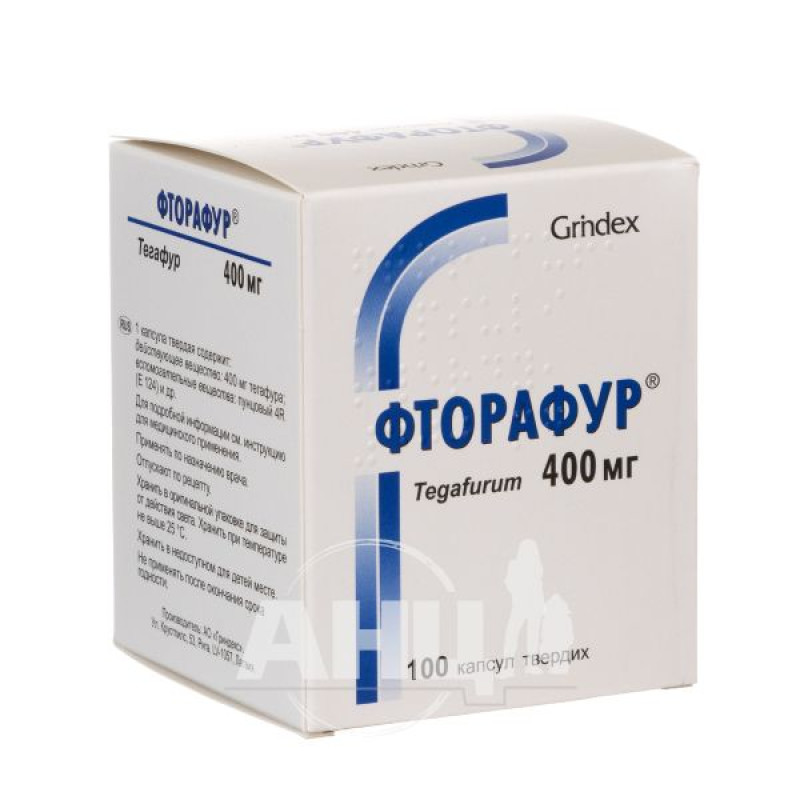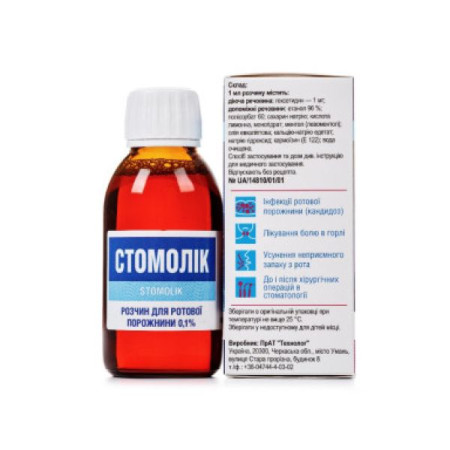Ftorafur capsules 400 mg container No. 100

Pharmacological properties
Pharmacodynamics. Tegafur and its sodium salt have an antitumor effect and are similar in biological properties to fluorouracil. Tegafur can be considered as a transport form of fluorouracil, which is formed in the body as a result of the activation of tegafur by liver microsomal enzymes. The metabolite of tegafur circulates in the body for a long time, thus ensuring the high effectiveness of the drug.
During the metabolism of fluorouracil, 5-fluoro-2'-deoxyuridine-5'-monophosphate is formed, which significantly reduces the activity of thymidyl synthetase. Under such conditions, a deficiency of thymidine-5-monophosphate occurs (which can be considered a specific precursor of DNA), which causes the process of cell division to stop, including malignant cells. In addition, another metabolite of tegafur, 5-fluorouracil-5-fluorouridine-5'-triphosphate, is incorporated into the RNA chain and replaces uracil, which is also accompanied by RNA disorders. It is important to emphasize that tegafur causes more pronounced biosynthesis disorders than fluorouracil. This indicates that tegafur acts not only as a transport form of fluorouracil, but also independently. The cytostatic effect of tegafur is based on its ability to influence the RNA metabolism of slowly growing tumor cells (with little proliferation). Such tumors include gastrointestinal adenocarcinoma.
The best results were obtained when using fluorafur for the treatment of tumors of the gastrointestinal tract (stomach, colon and rectum) and breast cancer. The duration of remission in the case of rectal and colon cancer is 5-8 months; in breast cancer - 10-19 months.
Fluorofur has a positive therapeutic effect in cases of malignant tumors of the bile ducts, pancreas, urinary system, as well as in cutaneous lymphoma and diffuse neurodermatitis.
Fluorofur is effective in the complex therapy of cervical cancer (in combination with radiotherapy and chemotherapy (cisplatin, capecitabine and interferon)).
In animal experiments, high antitumor efficacy of tegafur was revealed. High sensitivity to tegafur was noted in many experimental tumors (for example, in breast tumors, sarcoma 180, Walker carcinosarcoma, Harding-Passi melanoma). Tegafur has a strong antitumor effect in leukemia L-1210, hemocytoblastosis La and lymphocytic leukemia, while lymphosarcoma Plis, sarcoma Jensen, NK carcinoma and adenocarcinoma 755 are less sensitive. Leukemia P-388, L-5178, lung carcinoma Lewis, melanoma B16 and sarcoma 45 are resistant to tegafur.
The drug also has anti-inflammatory and analgesic effects, and reduces itching.
Pharmacokinetics. The pharmacokinetic properties of tegafur are based on its high lipophilicity (250 times greater than that of fluorouracil).
Absorption: when taken orally, tegafur is rapidly absorbed in the gastrointestinal tract, C max is reached after 3 hours and is detected in the blood for at least 24 hours after its single administration.
Distribution: The drug rapidly crosses biological membranes and is distributed throughout the body, including brain tissue. The bioavailability of tegafur from the digestive tract is 3 times greater than that of fluorouracil.
The bioavailability of orally and intravenously administered tegafur is similar (AUC is 668 and 510 ng/mL/h, respectively).
Metabolism and excretion: tegafur is metabolized in the liver to form metabolites, among which the pharmacologically active fluorouracil occupies a central place. The release of fluorouracil from the tegafur molecule depends on the dose and type of administration; the concentration in the blood plasma of 0.1-1 mg/ml is maintained for 48-96 hours. bioactivation is carried out not only in the liver, but can also be local in tumor tissue, which is characterized by an increased content of cytosolic hydrolytic enzymes.
Tegafur is mainly excreted from the body with urine and only 0.8% with feces. Experiments have shown that in urine 60% is unchanged tegafur, 10% is fluorouracil and only 5% is active metabolites of tegafur. After 12 hours there is a significant decrease in the amount of active substance, so it is recommended to use tegafur with an interval of 12 hours.
Pharmacokinetics in special patient groups
In elderly patients, tegafur should be used with caution due to possible impaired liver, kidney, and heart function, as well as the presence of concomitant diseases.
The safety and effectiveness of tegafur in children and adolescents have not been established.
Patients with impaired renal and/or hepatic function should have their renal and/or hepatic function monitored when using tegafur. Tegafur should not be used in severe renal and/or hepatic insufficiency.
Indication
Cancer of the colon and rectum, stomach, breast, cervix, skin lymphomas.
Application
Capsules should be taken orally 1 hour before or after meals. The dose should be selected individually depending on the patient's tolerance of the drug.
Tegafur monotherapy. When administered orally, the daily dose of tegafur is 20-30 mg/kg body weight (1.2-1.6 g or 3-4 capsules), but can reach 2 g (5 capsules); the dose should be divided into 2 doses and taken daily every 12 hours or 2-4 times a day. The course dose when taken orally is 30-40 g. The duration of the course of treatment is usually 28 days, with an interval between courses of 7 days.
In combination therapy regimens and as an adjunct to radiotherapy, tegafur should be used at a dose equal to or lower than that used in monotherapy.
In chemoradiotherapy of cervical cancer, use 800-1200 mg of tegafur 2 times a day. Depending on the individual tolerance of chemoradiotherapy, the daily dose of tegafur should be increased from 800 to 1200 mg in 2 doses during the course of treatment (12-20 mg/kg of tegafur per day with an average patient body weight of 60 kg). The exact dose of tegafur during radiomodification is determined by the doctor depending on the patient's body weight and concomitant diseases.
Children: The safety of tegafur in children and adolescents has not been established, so its use is contraindicated.
Contraindication
Hypersensitivity to the drug; terminal stage of the disease; acute profuse bleeding; severe functional disorders of the liver and / or kidneys; leukopenia (3 109 / l), thrombocytopenia (100 109 / l) and anemia (hemoglobin level 30 units).
Side effects
The following adverse reactions are classified according to organ systems and frequency: very common (≥1/10), common (≥1/100 to <1/10), uncommon (≥1/1,000 to <1/100), rare (≥1/10,000 to <1/1,000), very rare (≥1/10,000), including isolated cases.
Infections and infestations: rarely - symptoms of leukoencephalitis.
From the blood and lymphatic system: very often - inhibition of hematopoiesis, anemia, thrombocytopenia, leukopenia; rarely - febrile neutropenia.
On the part of the immune system: often - hypersensitivity reactions.
Tegafur, when used in therapeutic doses, causes a slight immunosuppressive effect on the overall reactivity of the body, on indicators of nonspecific cellular and humoral immunity.
Metabolism and nutrition: often - dehydration of the body.
From the nervous system: often - dizziness, drowsiness, loss of smell, change in taste.
When comparing oral and intravenous administration of tegafur, lower toxicity and a weaker intensity of side effects were found in the case of oral administration, especially regarding undesirable symptoms from the CNS.
Cardiac: very rarely - angina pectoris, also angina pectoris at rest.
Respiratory, thoracic and mediastinal disorders: rarely - interstitial pneumonia.
On the part of the digestive system: very often - nausea, vomiting, anorexia, diarrhea, intestinal colic, especially at the beginning of therapy.
If the toxic effect of the drug increases, it is necessary to either adjust the dose of tegafur or discontinue its use.
Often - stomatitis.
Particularly severe side effects are stomatitis and diarrhea, which usually develop in the final stage of therapy, when a total dose of tegafur of 50 g or more is reached.
Rarely - in especially severe cases, ulcerative esophagopharyngitis, duodenitis or duodenal ulcer develops.
Very rarely - acute pancreatitis.
From the liver and / or biliary tract: often - impaired liver function; rarely - acute hepatitis.
Skin and subcutaneous tissue disorders: often - dermatitis with maculopapular, itchy rash; hair loss, nail damage, dry skin.
From the kidneys and urinary tract: rarely - impaired renal function. In case of impaired renal function, tegafur metabolites may accumulate in the body, which sometimes cause an increase in the toxic effect of the drug.
Laboratory tests: often - increased ALT and AST levels.
Tegafur is not characterized by accumulation of toxic effects.
Special instructions
When prescribing tegafur, special attention should be paid to patients with impaired hematopoietic, liver and kidney functions, glucose metabolism, gastric and duodenal ulcers, a tendency to hemorrhage, infectious diseases. Blood counts, liver and kidney function should be regularly monitored. With prolonged use of the drug, its side effects increase.
Diarrhea is a common side effect of tegafur. Patients with severe diarrhea should be closely monitored and fluid and electrolyte replacement therapy should be administered to prevent potentially fatal dehydration.
The severity of dizziness, nausea and vomiting decreases with fractionation of the daily dose. If serious side effects develop, the drug should be discontinued.
It should be borne in mind that the drug suppresses the patient's reproductive function.
The capsule cap contains a dye - bright red 4R (E124), which may cause allergic reactions.
Use during pregnancy and breastfeeding. There are no clinical studies on the use of tegafur during pregnancy. Tegafur, like other cytostatics, may adversely affect the fetus, therefore its use during pregnancy is contraindicated.
Women of reproductive age and men must use effective contraception while using the drug and for up to 3 months after discontinuation.
It is not known whether tegafur passes into breast milk. If tegafur therapy is absolutely necessary for the mother, breastfeeding should be discontinued.
Ability to influence the reaction speed when driving vehicles or using other mechanisms. If drowsiness or dizziness occurs when using tegafur, you should refrain from driving vehicles and working with mechanisms.
High efficacy and relatively good tolerability allow the inclusion of fluorafur in combination therapy regimens. In the case of combination chemotherapy, fluorafur successfully replaces fluorouracil. Combination chemotherapy is more effective in those patients who have not previously received specific tegafur therapy. After combination chemotherapy, inoperable tumors can become operable, and metastases regress during prolonged remission.
The cytostatic effect of fluorofuran is enhanced by uracil, thymidine, methotrexate, cisplatin, N-(phosphateacetyl)-L-aspartic acid, leucovorin, tamoxifen, and other antitumor drugs that do not have cross-resistance to tegafur.
The combination of tegafur with leucovorin provides patients with gastrointestinal cancer with more pronounced therapeutic efficacy and easier tolerability of side effects.
The simultaneous use of tegafur, nonspecific immunomodulators, and agents that increase the body's protective properties (levomizol, interferon) has a beneficial effect.
In certain circumstances, tegafur can be used as an adjunct to radiation therapy. The best results of therapy have been obtained in patients with small, localized tumors of the stomach and rectum.
Concomitant use of tegafur and phenytoin may potentiate the effects of phenytoin.
Tegafur should not be used simultaneously with the antiviral drug sorivudine and its chemical analogue brivudine, as these substances increase the toxicity of tegafur.
The simultaneous use of tegafur and coumarins (warfarin) may enhance the anticoagulant effect of warfarin, therefore, patients using tegafur and warfarin should regularly monitor prothrombin time or international normalized ratio.
Concomitant use of filgrastim and tegafur may increase the severity of neutropenia.
Metronidazole may increase the risk of developing toxic effects of tegafur.
Tegafur (as it is a cytotoxic drug) should not be administered simultaneously with clozapine (risk of agranulocytosis).
Overdose
Symptoms: increased toxic effects on the gastrointestinal tract, central nervous system and suppression of hematopoiesis (leukopenia, anemia).
Treatment: monitoring of hematopoietic function for at least 4 weeks, if necessary, symptomatic therapy is performed.
No specific antidote is known.
It should also be taken into account that some enzyme systems involved in tegafur metabolism are impaired, resulting in the accumulation of active tegafur metabolites in the body, which leads to increased toxic effects of the drug.
In subsequent courses of therapy, tegafur is metabolized less well, as evidenced by the excretion of a significant amount of tegafur unchanged from the body. In addition, the tumor becomes more resistant to tegafur.
Storage conditions
In the original packaging to protect from light at a temperature not exceeding 25 °C.
There are no reviews for this product.
There are no reviews for this product, be the first to leave your review.
No questions about this product, be the first and ask your question.










